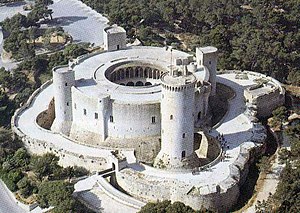Bellver Castle
| Bellver Castle | |
|---|---|
| Palma de Mallorca, Spain | |

Aerial view of the castle
|
|
| Coordinates | 39°33′50″N 2°37′10″E / 39.56375°N 2.619338°ECoordinates: 39°33′50″N 2°37′10″E / 39.56375°N 2.619338°E |
| Height | 112 m |
| Site information | |
| Owner | Palma de Mallorca City Council |
| Site history | |
| Built | 1311 |
| Built by | Pere Salvà |
| Materials | Marès |
| Official name: Castillo de Bellver | |
| Type | Non-movable |
| Criteria | Monument |
| Designated | June 3, 1931 |
| Reference no. | RI-51-0000411 |
Bellver Castle (Catalan: Castell de Bellver) is a Gothic style castle on a hill 3 km to the west of the center of Palma on the Island of Majorca, Balearic Islands, Spain. It was built in the 14th century for King James II of Majorca, and is one of the few circular castles in Europe. First serving as the residence of the Kings of Majorca, and afterward long used as a military prison throughout the 18th to mid-20th century, it is now under civilian control, being one of the main tourist attractions of the island, as well as the seat for the city's History Museum.
The castle's plan, a circular floor with round towers attached to it, seems to have been inspired by the upper complex of the Herodion, a 15 BCE hilltop palace in the West Bank, that was also circular and had a large principal tower and three minor towers as well. They are attached while the principal one is coupled to the complex by a high bridge over the surrounding moat.
The main part of the fortification was built by architect Pere Salvà, who also worked in the construction of the Royal Palace of La Almudaina, together with other master masons between 1300 and 1311 for King James II of Aragon and Majorca. Rock from the hill where the castle sits was used for the building, which has eventually led to the appearance of cracks. Once the castle had been built, and following the introduction of artillery, the battlements on the top balconies and the barbican disappeared, being soon followed by those in every tower; loopholes were built instead.
The castle originally served as a residence for the Kings of Mallorca whenever they were not staying in mainland Europe, and was subsequently seldom used as a residence for viceroys during the 17th century. As a fortification, it suffered and successfully resisted two sieges during the Middle Ages; the first of them in 1343, during Peter IV of Aragon's campaign to reincorporate the Majorcan territories to the Crown of Aragon, and then again in 1391 during an anti-semitic peasant revolt. The castle has only fallen once in its history into enemy hands, in 1521 after an assault during the Majorcan seconds Revolt of the Brotherhoods.
...
Wikipedia
